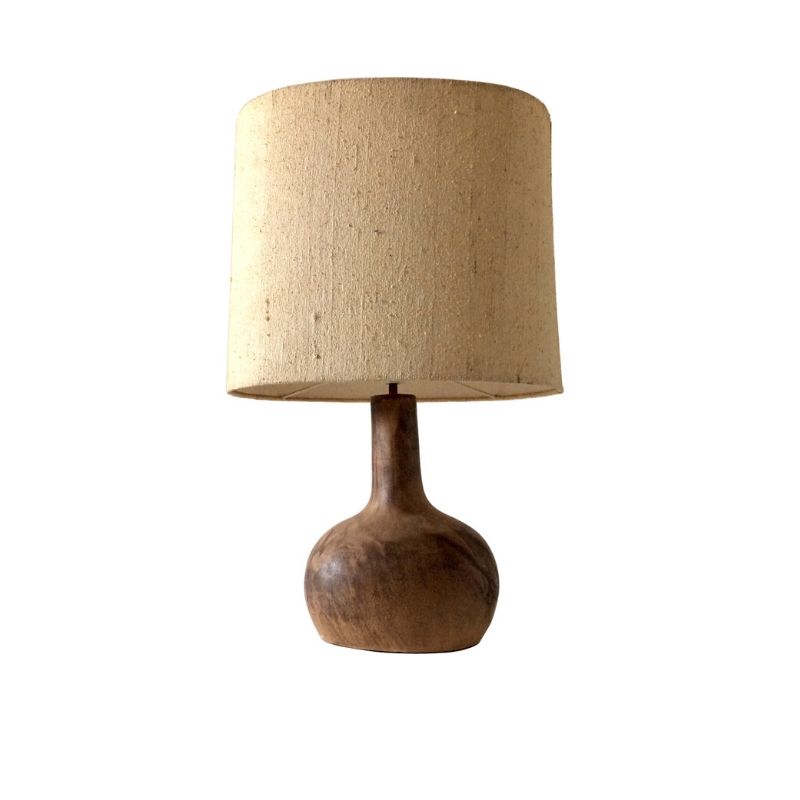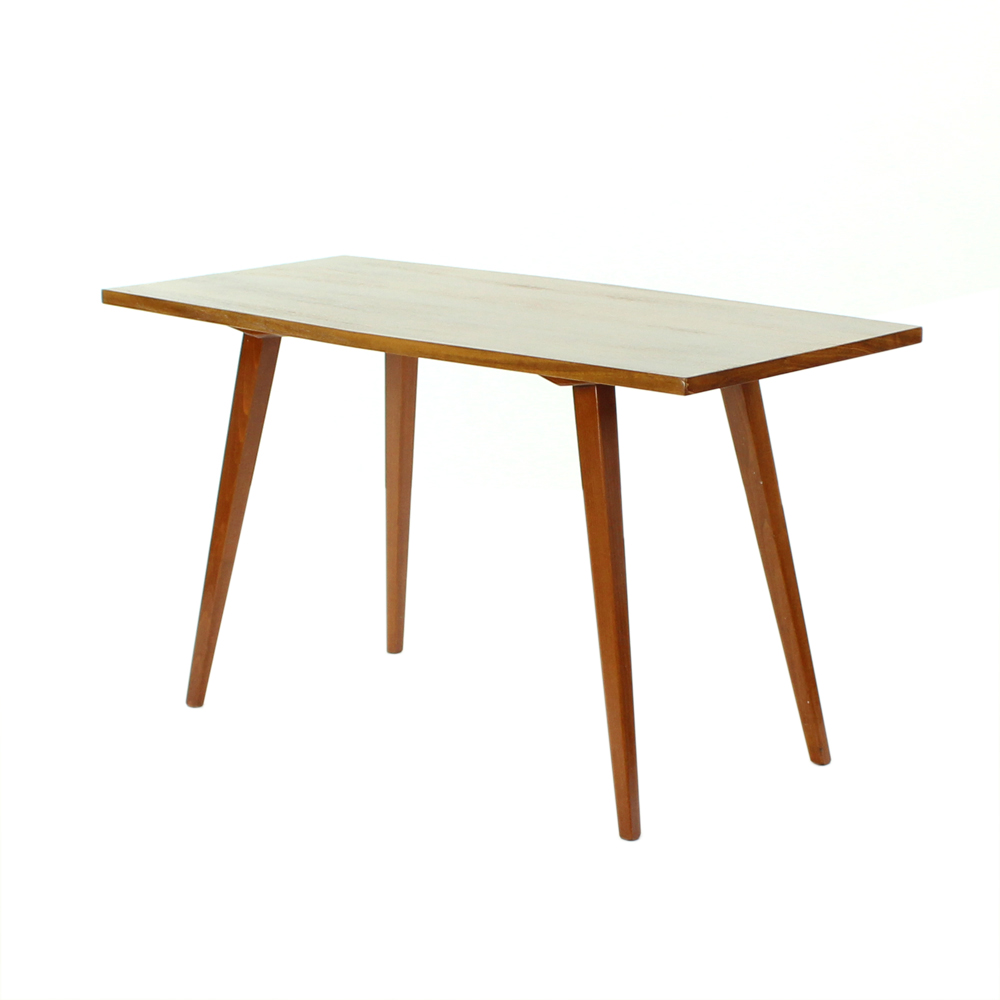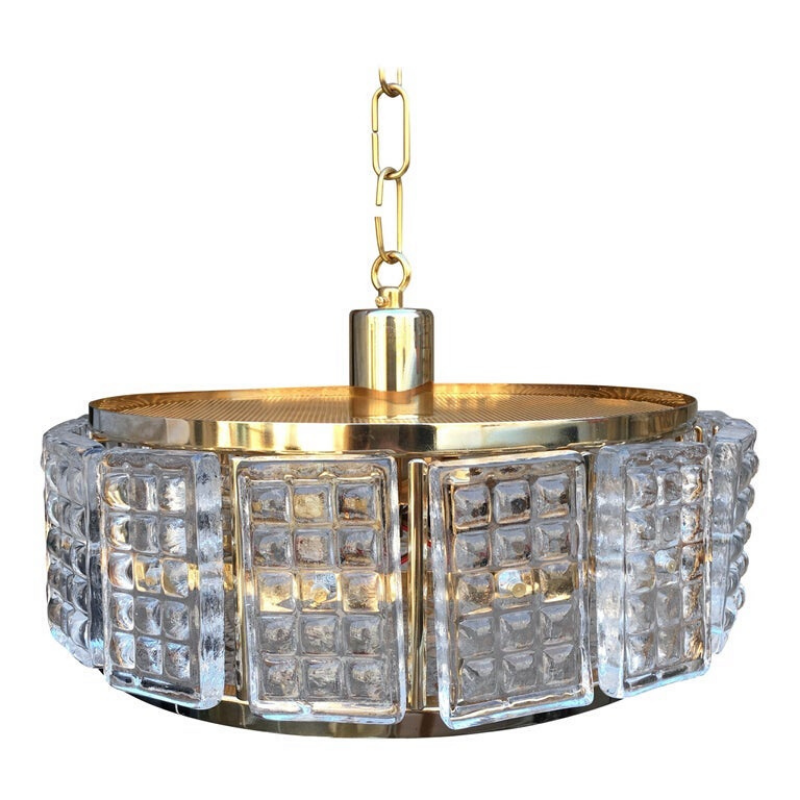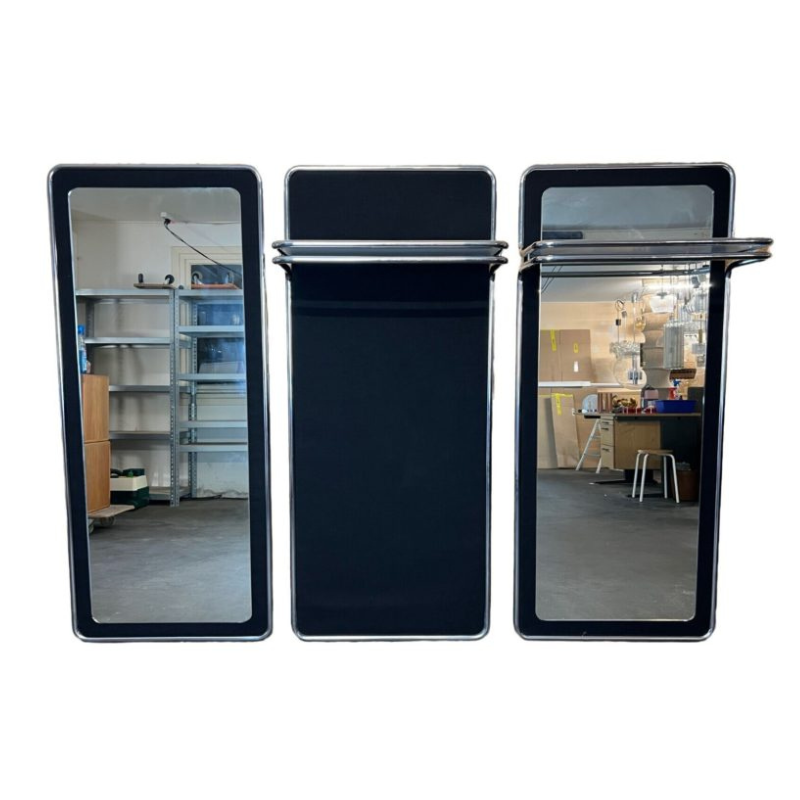I think the seat looks original and like good patina. The rest of the chair is a bit over abused for me. All I see is the "patina" and not he design. For me, this is a clear indication that it is over the line.
I believe that there will be enough give to push the cord away from the legs and then put a tack in the stretcher to hold it. Then you can mask it all off with plastic and painter tape.
I wouldn't strip it entirely. You just need to sand the paint so that it is smooth. And any loose paint needs to come off.
Then finally use a high gloss ENAMEL spray paint.
Fair enough, Leif, but I'd advise testing for compatibility before spraying without a thorough stripping/prep prior. I agree that the seat looks good, but I also agree w cd that it's almost an all-or-nothing proposition as far as complete restoration is concerned. These are tough calls without personal inspection.
@DrPoulet, if you were to push the seat cord aside it might reveal whether the black finish is indeed original or not!
I love this forum!
Ok , i have done the lacquer test with nail polish remover, the color comes off a bit and it leaves the paint kind of dull.
After further inspection, here is what I can tell you:
* Except for a few normal nicks, the wood is not damaged at all.
* joints are tight.
* the cord seat is in very good condition and very well done. There are not that many people able to do it properly around here so I am pretty sure it is original.
* on the top of the back rest (sorry I do not know if there is a name for that), the paint is kind of cracked, like if it is peeling. But yet it won't go easily.
* In the areas where the paint has gone, there is some kind of light grey coating, not raw wood. Probably a primer.
* I am pretty positive the wood is beech.
* if you push the cord a bit, the color of the rail is faded but it seems to be black. It could be very dark blue or very dark grey as well.
* the FDB mark under the armrest says that the chair has been produced in 1966. According to the 1967 FDB catalog, the J16 chairs came in black, white or beech.
I don't think the chair has been left outside as the wood and the cord seat would show some damages as well.
I like these rocking chairs better in black but I am not too attached to the color. Wood finish would be fine (and it would be a finish that actually existed). I am starting to think that it might be a better idea to remove all the paint and primer, gently sand the chair and oil it.
Well, I do not know what the original finish was (oil, varnish,...) but I know a dealer nearby who has one so I can check.
And a close up picture of the peeling paint of the backrest. It really goes if you scratch it with the nails. It is strange because the paint is only in this condition on the backrest. It does not peel on armrests and feet.
I have no idea what have caused this peeling but I think the paint damages comes from that, probably helped with years of nail stractching (it is actually tempting)
The damages on the armrest look indeed like somebody tried to sand it and gave up. The blueish stains being half sanded paint.
I guess that if I leave it as it is, the paint will continue to peel off.
I guess my only reasonable option is stripping the paint, hand sanding the chair and leave the wood unfinished or soaped (never did it so it will be a chance to try). I have checked Fredericia website to see what are the finish available and unfinished beech and soaped beech both exist.
I guess the rails will be a pain to refinish without damaging the cord but it should not be undoable with a great deal of care and patience....
The rails on this chairs are only going to be finished where the cord does not cover.
Per tktoo, do a quick compatibility test with the spray paint. However, I put enamel in capitals, because it is oil based and ought to stick well. Latex water based spray paint is a much more delicate chemistry and it probably will not stick.
If the enamel spray paint does not stick, for some reason, you could do a coat of shellac. It is hard to put on uniformly, so read up on your technique, and prepare to sand out lines in the shellac. But I really don't think it will be necessary.
I have put oil based finish over the original finish on a J16 before. It was one of the rare brown ones the factory did In the early 1970s. Unfortunately the mix of pigments gets 'burned' by UV light and turns a sickly green. One side of he poor chair was green and the other brown. This is the same thing that happens to Selig's 'saddle' finish. Anyway, the point is I have successfully done this before. I just wish that I had used enamel spray paint instead of oil based gel stain. It would have been much easier to get a smooth, proper finish.
I would really caution against stripping this chair. It is goin to be a massive amount of work and it will be very hard to get the paint out of the many corners. Also finishes tend to unevenly soak in to beech wood, so some areas will have a very deep dark stain. Others will be fine almost immediately. You may have to sand the wood far, far more than you want to remove the deeply soaked areas completely.
The closeups now have me suspecting that the areas showing paint loss may have been top coated or cleaned with some kind of product that reacted with the black lacquer. Either that or the original primer was defective and/or the chair was stored in a high-humidity environment for too long. Or any combination of the previous. What's confusing is that the areas of loss are so localized and defined. A little mystery.
The photo of the crest rail nicely illustrates various conditions in the paint layer with terms like "traction cracking", "cupping", "tenting", and (my favorite), "active cleavage" ...because, after all, what good is cleavage if it's not active.
I just would be leery of putting any finish over an existing one that is failing. I don't know how you can be sure that the old finish won't continue to fail under the new finish.
If you want to go with a soaped or oiled finish on bare beach, just be advised that any pigment that you can't remove from the pores of the wood will be more visible when the chair is soaped or oiled. If you are ok with that--great. If you want a cleaner look, it might bother you.
This is my J16 that I stripped, bleached, bleached again, sanded, soaped, rinsed off, and sanded again: https://www.designaddict.com/forum/Repair/restoring-weathered-beech-wood-... (It was actually varnished, not lacquered.) The staining is too deep and it still looked unsightly with a soap finish with added white pigment, so it will be black. I like these chairs best in black so that's fine with me.
The only thing about the seat are the slots at the back. The cord there will be difficult to mask off completely. Sanding may be your best option for dealing with the old finish and then putting the new finish on in those areas with a small artist brush. I do think you should do whatever needs to be done to preserve the seat.
Bumping this thread because I just started restoring a pair of these and had some questions for the experts.
These are Beech and the original finish. Lots of loose joints, and the finish is flaking off in many areas. The goal is to get them looking nice without damaging the seats, which are sorta loose and faded/dirty, but in good enough shape to leave alone.
I got started this morning and before I knew it, I'd taken apart most of one of the chairs. I stripped the loose pieces and as much as I could without coming too close to the seat. I'm planning to carefully sand the old finish off in those areas. So far, at least with this one chair, it's looking pretty straightforward. As leif describes, I think I can mask off the cord and finish them in lacquer.
My main question is the seats... I've read what I can here on the soap flake method. Think that is the way to go here? What experience do any of you have with solvents coming into contact with the cord? Like lacquer thinner. I imagine it would just dry it out. I've also read that wax or oil is better than soap... not really sure. The cord doesn't need to look brand new (in fact I think it would be best if it didn't) but there is some discoloration and dirtiness that I'd like to address. Thanks.
Yes, cleaning with the soap flakes in water DOES work! The Danes have been using this on pine floors (same material--cellulose) for centuries and it works amazingly well. I have successfully used it to clean both dirty pine floors and stained paper cord seats. I don't know that it will get out very deep, dark stains on paper cord but it will lighten them, and it's pretty good at evening out lighter stains to the point where they are not noticeable.
You may have to do a couple of treatments. Just do NOT scrub or rub the wet cord. Let the soapy water soak in, then blot it up. Wet paper is way more fragile than dry paper.
Danish paper cord used to be made with a waxy coating but I read that that's no longer the case. I've never seen any new stuff with wax. I have never heard of anyone oiling it either---maybe it's been done but it's not a common thing at all. I would just go with soap. When the cord dries you can't tell that it's any different than unsoaped cord. Just be sure that every bit of soap is dissolved before you start! Undissolved bits will settle into crevices and will be visible after the seat dries. I use plain old Ivory bar soap that I grate with a food shredder thing---it takes a long time to dissolve unless you heat it on the stove. Some Danish friends told me me it's essentially the same as the flakes.
I have never gotten solvents on any of the countless seats I've woven because I have the luxury of getting all of that stuff done before I start on the seats. BUT---I don't think a one-time-only contact with solvents will compromise the strength of the cord. I think the only problem would be that you can tell where the wet area ended (like a water mark).
Thanks spanky! I guess my concern with the soap is that it might present problems in finishing... so it'd be best for after the finish is applied and dried/cured. I will come back to this later in the week when I am at that point. Or maybe I just won't bother with it... we'll see how the frames come together and maybe the seats will give them a nice, contrasting patina. Thanks again.
So here I've taken the plastic and tape off of the seat after putting on a couple coats of flat pre-cat lacquer.
You can see in one shot from the side that one chair still has some dark discolorations on the sides of the seat. Does this look like something that can be cleaned up with a soap treatment? Or would the treatment potentially lighten the rest of the seat and further highlight the dark spots?
Oh I should add that the cord seems to have responded well to the lacquer thinner and I think it cleaned it up in places, also.
I haven't done a ton of paper cord cleaning with soap, but what I have done has worked well on stains of about that darkness. Maybe it depends on what caused the stain, though--I really don't know. I have also used it on a pine floor that was quite dirty from 6 months' worth of muddy shoes and the results were amazing, though the floor had already had soap treatments before (which would have kept the dirt from getting too worked in).
I don't think it will intensify the contrast. It might while wet---but I think it'll dry to the same or will be less contrasty.
The Danes often add titanium white pigment to their soapy water when treating pine floors (or they use a floor soap with added pigment). I tried this on my J16 that had deep discoloration from weathering and it didn't really work. I wonder what it would do to paper cord? Maybe I'll test a sample.
That's kind of a hard seat to weave so you might want to think about just leaving it if you think you can get used to it. The chairs themselves look great! You're so lucky to have a pair!
Thanks spanky... I'm going to take the plunge. Question, though: does the water need to be hot, or does it work best when it is? I can dissolve the flakes at home but I don't have a stove or way to boil water in my workshop. Should I bring them home with me to do this? Or am I cool to heat up the mixture and make sure it's fully dissolved and then apply it at room temperature?
I ended up doing two treatments. Pretty simple and it did remove the worst of the darker discolorations and lightened the cord. Second application went even further, and I bet that with a couple more treatments, the seats would look a lot better. As it is, they look alright. It didn't exactly fix everything, but it was better than nothing. Thanks again for the advice.
If you need any help, please contact us at – info@designaddict.com









